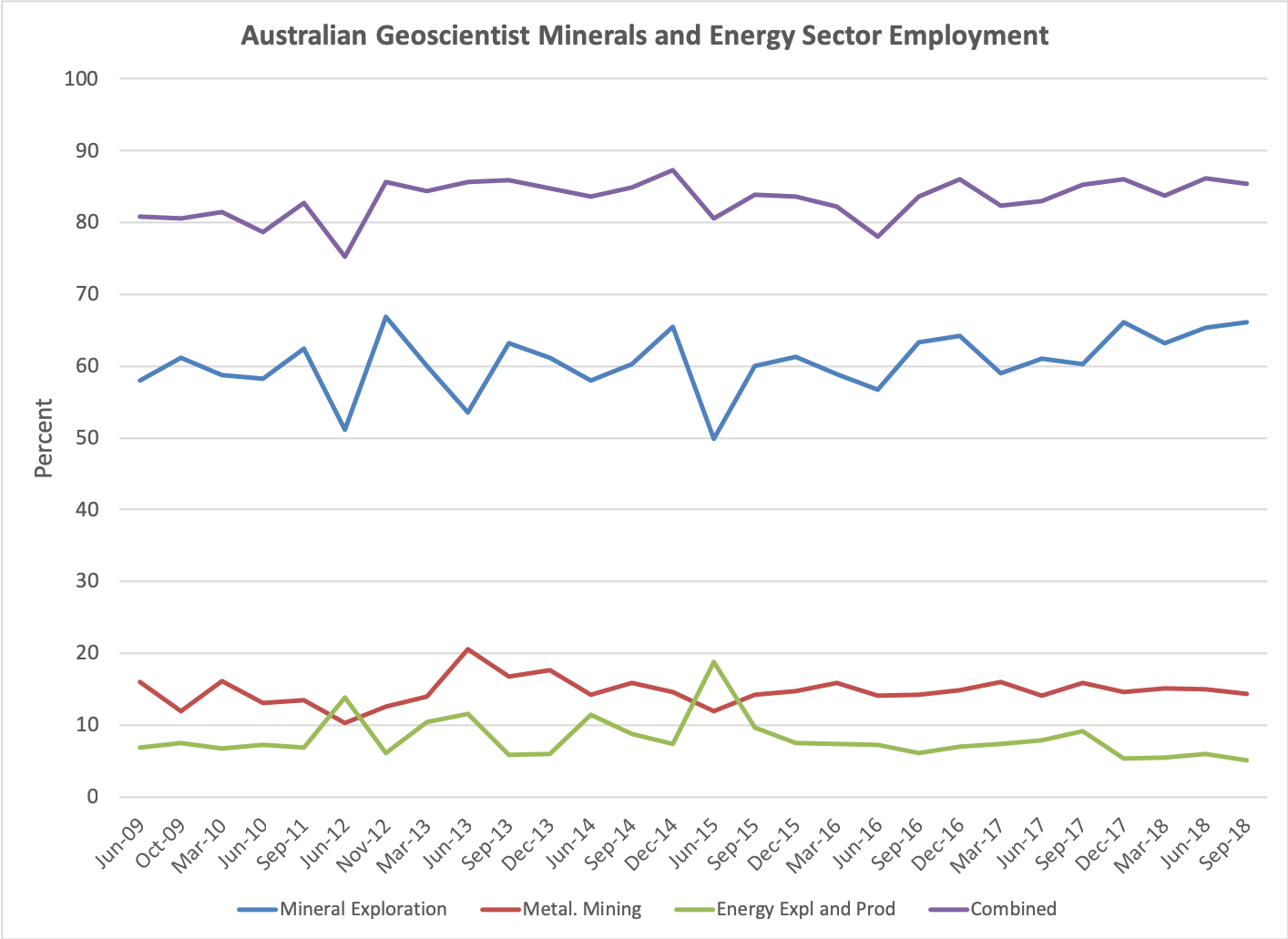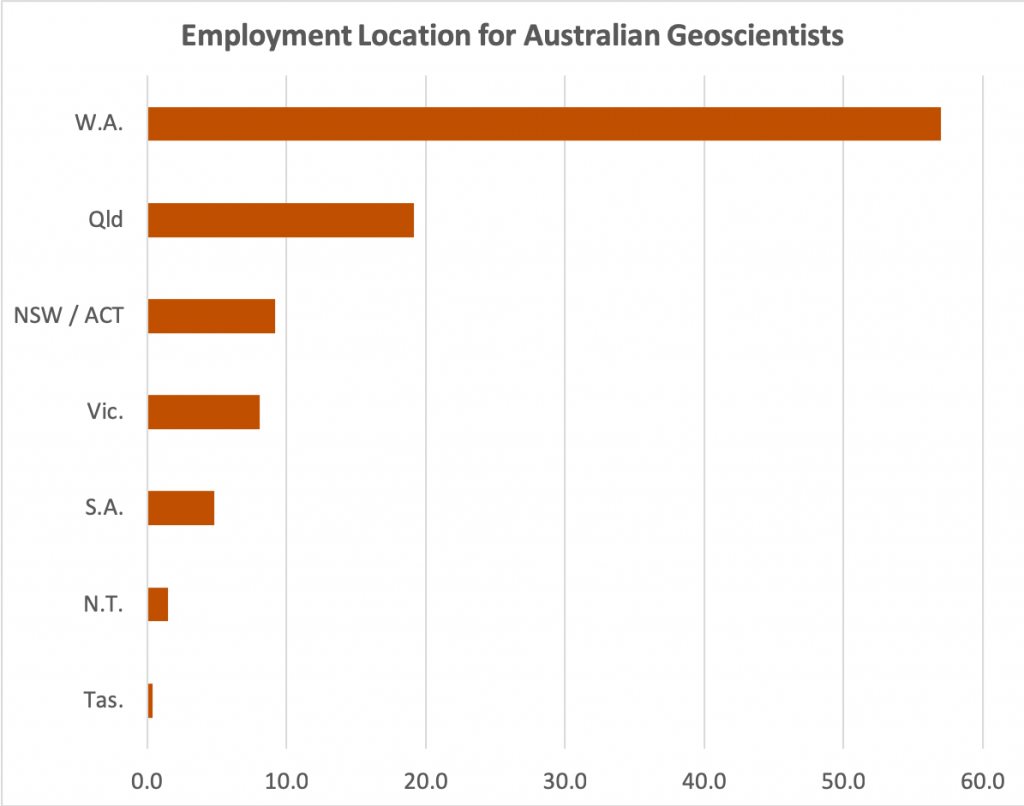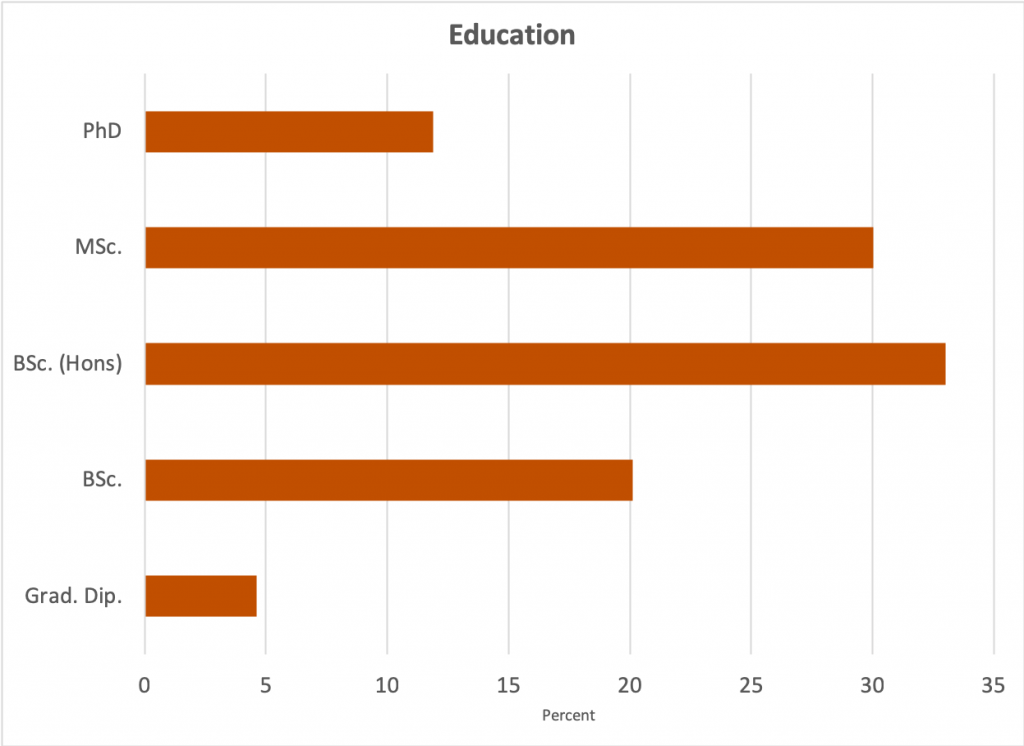AIG’s Australian Geoscientist Employment Survey has been running for almost ten years, regularly collecting data on employment prospects for geoscientists, as well as demographic data that provide insight into how our profession is evolving.
Since the surveys commenced, unemployment amongst Australian geoscientists has been as low as 1.6% in September, 2011, and as high as 19.5% in March 2016. We’ve seen a small fall in the proportion of geoscientists in full-time employment, from 74% in June 2009 to 69% in the September 2018 survey. There has been a similar fall in part-time employment from 4.5% to 3.3% for the same period. Self-employment (geoscientists working as independent contractors and consultants) has risen from 21% in June 2009 to 28% in September 2018.
Where are we today?
In September 2019, 89% of survey respondents were working, or seeking work as a geoscientist in Australia. 7% of respondents were not seeking work, 2% were retired but staying in touch with their former profession, and the remainder of respondents were working or seeking work in fields other than geoscience.
Mineral exploration, metalliferous mining geology and energy resource exploration and production employ 85.4 % of survey respondents, only slightly less than the peak of 87.4 % observed in December 2014.

This is vastly different to the situation in Europe and the USA, where environmental services, government agencies and academia are the greatest sources of employment for geoscientists. Fields of employment including diamond exploration, engineering geology, industrial minerals production, groundwater resource management, environmental geoscience, government geoscience and other fields are relatively small contributors of employment opportunities.

More than half of the geoscientists working in Australia are Western Australia based. More than ten percent of Australian-based or educated geoscientists work overseas.

Almost 75% of Australian geoscientists have a Bachelors Degree with Honours (requiring a minimum of four years full time study at most Australian universities). Almost 42% have a Masters degree or PhD. Almost 80% received their highest degree in Australia, while more than 90% earned their highest qualification in Australia, New Zealand, Great Britain, Canada or the United States of America.

Our profession appears to be ageing. Almost one third of Australia’s geoscientists have been involved in the profession for more than 30 years. Assuming a new graduate enters the workforce at 22-23 years of age, 30 years experience points to one third of Australia’s geoscientists being in their mid-fifties. The proportion of young geoscientists, with five or less years of experience stands out in these figures as being low, at less than 6%. This could be due to geoscience failing to attract students, or to early career geoscientists not seeing value in professional association membership. Geoscientists, for example, cannot act as Competent Persons in compliance with the JORC Code until they have at least five years relevant experience. Not being engaged with their peers through professional association membership could simply reduce awareness of surveys like the ones on which this article is based. Should the former proposition be true, however, our profession has a major problem that requires a concerted effort to attract more talented students to geoscience studies and careers.

Diversity was a hot topic in scientific circles throughout 2018. Overall, 85% of Australian geoscientists are men. The ratio of men to women geoscientists varies considerably, however, with years of experience. The greatest proportion of women in geoscience is amongst early career geoscientists, with less than five years experience, followed by mid-career geoscientists with 10 to 15 years experience. The proportion of women entering the profession of just under 30% demonstrates that more needs to be done to attract and retain women by Australian geoscience if greater gender balance is to be achieved. The goal of gender balance in the profession will only be achieved by a sustained effort over several decades.
The proportion of women with an honours degree or higher is 82%, greater than men with 74%.


Participation on different industry sectors varies considerably. Relatively few women work in mineral exploration, leading to greater participation in mining, energy resource exploration and production, government geoscience, engineering geology, industrial minerals and environmental geoscience.

In conclusion, this review of some of the survey results over time yielded a few surprises. Despite the highly cyclical nature of mineral exploration, it remains the dominant form of employment for geoscientists working in Australia. Fields where employment opportunities have grown considerably in the USA and Europe, including groundwater management and environmental geoscience, continue to be only a small part of Australia’s geoscience scene. This is surprising, given pressures on land for development in major cities where remediation of old industrial sites is a major source of land for urban development and the reliance of cities and towns on groundwater for an increasing proportion of their water needs has increased over the past ten years.
Does this raise questions regarding Australia’s focus on environmental stewardship more generally if we are not seeing an increased focus on these fields?
Similarly, engineering geology remains a relatively small sector of the geoscience profession, again against a backdrop of development of more difficult land for housing, industry and commercial uses in our major cities.
The figures can certainly be interpreted to demonstrate the importance of Australia’s resource industries to our economy, with the discovery of new mineral resources and stewardship of existing ones remaining the principal source of demand for geoscience capabilities.
Our profession is arguably making progress towards becoming a more diverse employer in Australia, but gender balance isn’t going to be achieved overnight. Achieving this will require sustained effort over decades, requiring commitment from all sectors of our profession. This occurs alongside an overarching need to ensure talented students are attracted to geoscience careers, which may well prove to be a significant contributor to geoscience in Australia in many ways.
Andrew Waltho